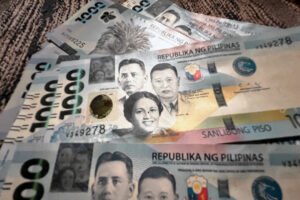




Philippines Trade Update: Trade trajectories trend along
 DOWNLOAD
DOWNLOAD

Policy Rate Updates: Double cut finale
 DOWNLOAD
DOWNLOAD

Monthly Economic Update: One for the road
 DOWNLOAD
DOWNLOAD


Peso’s nonstop fall may stoke prices

A prolonged depreciation of the Philippine peso could stoke inflation, though it could also benefit the economy by boosting export earnings, analysts said.
“We see the peso’s weakness against the dollar persisting,” Ruben Carlo O. Asuncion, chief economist at Union Bank of the Philippines, Inc., said in a Viber message on Wednesday.
“The BSP has to be ready, as they have done in the past, to intervene and battle volatility and speculative play,” he added.
Diwa C. Guinigundo, country analyst at GlobalSource Partners, said the peso’s weakness could boost export competitiveness “as long as its pass-through to inflation does not exceed the benefits of external competitiveness.”
“That is growth positive,” he said in a Viber message. “As long as the peso avoids a sharp and prolonged depreciation, the impact on inflation could be manageable. Otherwise, imported inflation could be very problematic.”
The peso closed at PHP 58.06 against the dollar, 21 centavos stronger than on Tuesday, when it closed at the weakest level in 18 months, according to Bankers Association of the Philippines data.
The currency has depreciated by PHP 2.69 this year from its PHP 55.37-a-dollar close on Dec. 29, 2023.
Mr. Guinigundo, a former central bank deputy governor, said the peso could strengthen if the Bangko Sentral ng Pilipinas (BSP) turns more hawkish again.
“Any hint of the BSP’s less hawkish stance could move the market,” he added.
BSP Governor Eli M. Remolona, Jr. last week said the central bank could cut rates as early as August and earlier than the Fed amid easing inflation. He also expects one or two 25-basis-point rate cuts in the second half.
The peso is likely to be dragged down by the widening balance of payment (BoP) deficit, Mr. Guinigundo said.
The payment position widened to a USD 639-million deficit in April from the USD 148-million gap a year earlier, according to BSP data. This was also a reversal of the $1.17-billion surplus in March.
The BSP expects the country’s BoP position to end at a $700-million deficit, equivalent to 0.1% of economic output.
Juan Paolo E. Colet, managing director at China Bank Capital Corp., said the peso’s weakness could affect companies with dollar loans.
“Our currency’s weakness will have an impact on companies that have borrowed in US dollars but whose revenues are mainly in peso, because it becomes more expensive to [pay] the debt,” he said in a Viber message.
The peso has been weaker than its regional peers, and it’s mainly depreciating due to the Philippine central bank’s dovish tone, Emilio S. Neri, Jr., lead economist at Bank of the Philippine Islands, said in a Viber message.
“The Philippine economy’s narrowing current account deficit combined with possible softening of forthcoming US inflation may cap what seems to be a near-term overshoot of the exchange rate versus its expected medium-term trend,” he added.
The BSP estimates a $6.1-billion current account deficit this year, or 1.3% of economic output.
Companies welcome an earlier rate cut by the BSP because it is a sign of slowing inflation, Jonathan L. Ravelas, senior adviser at Reyes Tacandong & Co., said in a Viber message.
Inflation quickened to 3.8% in April from 3.7% in March, still within the central bank’s 2-4% target for the year. It was slower than 6.6% a year earlier.
It averaged 3.4% in the first four months, below the BSP’s 3.8% full-year forecast.
Mr. Ravelas said the peso would probably remain at the PHP 58 level as long as the BSP remains dovish. — By Aaron Michael C. Sy, Reporter
This article originally appeared on bworldonline.com





 By BusinessWorld
By BusinessWorld